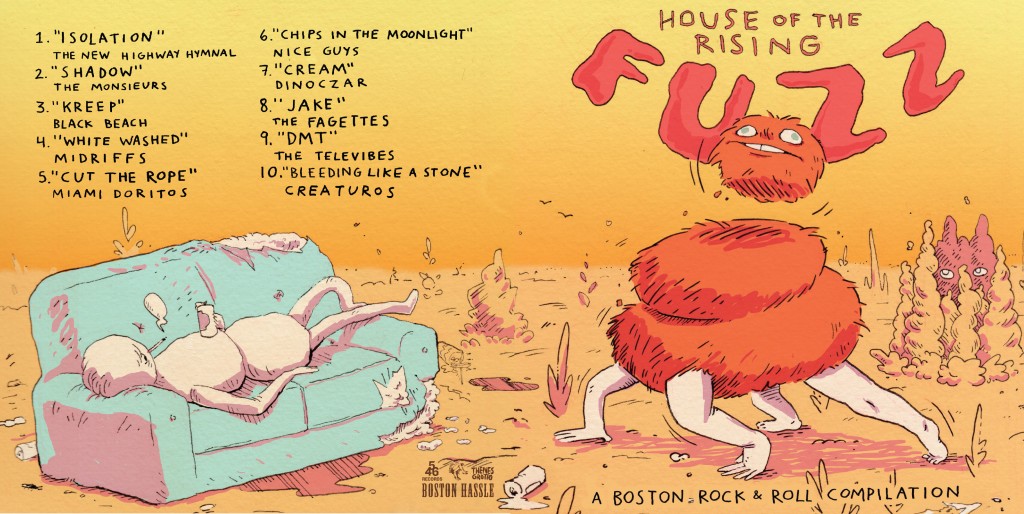The word “scene” is a mischievous one. Some people understand it, some don’t, while others take offense at the very idea of its existence. In a city with countless different ideas, artists, and cultures, how do you go about defining or even capturing our “scene” as a collective idea?
Here in Boston, the sound leans towards scuzzy rock n’ roll music. On a good weekend, be it bar or basement, there will with almost certainty be twenty-somethings getting sweaty to overdriven vocals and a blown out amp or two.
Compilations are a good way of forming some kind of physical entity out of this loose term. Some fade into obscurity among forgotten record collections or lost between endless rows in record shops, while others have the potential to be something much larger. Whether they are vintage like Nuggets or No New York, or contemporary like Dark Was The Night, compilations have the potential to become infamous. If nothing else they are excellent timepieces. A well-curated album is a window to a certain era, and only grows more charming with time.
Boston has seen a few important comps come out of its scene, This Is Boston, Not L.A. being one of the more infamous. But recently, there hasn’t been a classic-in-the-making to come from the underground scenes here. But that could easily change.
House of the Rising Fuzz: A Boston Rock Compilation consists of one-song contributions from 10 local rock n’ roll bands that arguably serve as the backbone of Boston’s music scene. All songs are original, seven are exclusive to the compilation. The album is going to be brought across the country and distributed to independent record stores to give fans of good ol’ fashioned rock a taste of the East Coast.
Ben Semeta is 24 years old. He has a well-groomed beard, and works nine-to-five at McLean hospital and nights at the Middle East Nightclub. He moved to Boston about a year ago to make his commute easier on him (he plays bass for Black Beach, one of Boston’s many garage rock outfits). But more importantly, Semeta is the driving force behind the compilation, having unwaveringly driven its production steadily for over half a year now. And now after all his work, the album is ready to be released.
One day, while hanging out with Matt Garlick, a friend and fellow musician from Nice Guys, the pair half-joked about what bands they would put on a fantasy album of their favorite local bands. The idea started to take root from there.
Originally wanting the album brought to light for self-described “selfish reasons,” Sementa admits “I just wanted to hear all my favorite bands on one record.” But as it took form, the project became less about him, and more about a greater vision. He wanted to bring the sound of his city across the United States to give like-minded people a chance to hear what they might not have been able to before.
Originally, there were three shows planned for the album’s release, but then Fuzzstival was announced and Semeta decided to sell the record there, since most of the bands on the compilation are scheduled to perform. House of the Rising Fuzz isn’t directly affiliated with the fest, but Semeta says both he and the organizers share similar goals of community and trying to build a scene.
Semeta put together what he felt was an accurate summation of the rock scene undercurrent of the city. For the album, he enlisted his own band, Black Beach, and the likes of CreaturoS, The New Highway Hymnal, The Monsieurs, The TeleVibes, Midriffs, Dinoczar, Miami Doritos, Nice Guys, and The Barbazons (who were the Fagettes during the creation of the record and are credited to that name).
Semeta wanted the full project to be about all of Boston, not just the bands. The entirety of the album tries to capture the breathing beat of the city itself. He enlisted local artists Tj Freda for the graphic design of the album insert and Clark Jackson for the album art. “I look at it like we should all work together” he says to me in his room as he pulls record after record out of his vinyl collection. He comes across House of the Rising Fuzz and sets it spinning. The album crackles to life and with feedback-heavy tunes thump along one by one from the speakers. House of the Rising Fuzz is aptly titled.
He shows me the cover, which looks alien and cartoonish, almost like an otherworldly Allston. The album insert is a grid of ten photos from local photographers, and each band featured created their own art to go along with their songs.
“It’s just cool to be a part of something bigger” he says. He geeks out every time the record changes songs. The words “my favorite” and “ their best song yet” get thrown around repeatedly. But he is not wrong—every band sounds in their finest form.
Most of the rock n’ rollers on the comp are friends with one another, which made the overall organization a bit easier Semeta admits, although rounding up representatives from ten different groups is difficult enough, and that’s not even counting the fact that some musicians have a reputation for being impossible to get ahold of.
But despite a fair deal of forceful planning, slowly but surely the album became something more than a fantasy.
photo of Ben Semeta by Madison McConkey
Semeta and co. had it printed on 456 Records and Primordial Sounds. Sam Potrykous and Boston Hassle helped him locate record stores across the country. Nice Guys will distribute the album on their tour. Semeta stresses that the stores “don’t need to buy it, just take it from the band and put it on [their] shelves.”
The process was more of a labor of love than he originally expected. The album was originally planned to be released last March, but suffered setback after setback.
“I bit off a little more than I could chew to be honest,” he admits. To even get the project started, money had to be put into it, with every band pitching in enough to make a small profit. Semeta covered the rest with his tax refund. Even then he had some added funding help from the Grotto. Semeta doesn’t expect a profit. In fact, he’s considering just giving the album to record stores without charge to ensure they profit. To him, it’s about the shared experience of music. Semeta learned the hard way the shrewdness of the industry—he had never done this kind of operation before. He didn’t work directly with a label, so his experience with the business side of music is new. “The industry is a beautiful bitch,” he says.
The printing of the record was delayed because others were considered higher priority. “I knew the delay for my vinyl was because Jack White had to have his record store release pressed or something,” he says, pausing to add “Record Store Day is fucked.” Pressings for the audiophile’s coveted holiday are considered of a higher commercial importance, so companies tend to address them first, which Semeta believes makes harder for independent artists to function.
In a seemingly cyclical manner, after sending out the record, it would be rejected and sent back for reformatting; the art would need to be redone to fit the packaging or the tracks were too distorted. Semeta grew frustrated. “If we talked a few months before,” he acknowledges to me, a little defeated “I would’ve sounded more enthused.”
Now that the business side of the experience, which he calls a “nightmare,” is wrapping up, Semeta has gotten back some of his lost energy, adding that he’s “just pumped to finally get it out.” Despite his discontent with the process of making the record, it’s not hard to tell that it was a labor of love for everyone involved.
Many of the songs on this album find their respective bands at their peak. You can actually hear the energy pulsing in each tune, as if each act truly wanted to make their mark upon something bigger than they’re used to.
Andy Macbain from Monsieurs suggested it would be a cool time capsule for the participants to look back on with pride. Semeta wants to be able to hold the vinyl up and declare “that was my 20’s right there.” He favors vinyl as a physical tool to make you appreciate the album as a whole, which is ideal for this record, being best received as one whole aesthetic. In his room, he pulls out two gems from his collection that helped shape House of the Rising Fuzz; holding up Back From The Grave: 17 Rockin’ 1966 Rockers and Surf-Age Nuggets: Trash & Twang Instruments 1959-1966 (Volume I). His tastes ricochet between Electric Wizard and Ty Segall to The Beach Boys and Pity Sex. He beams at the “insane amount of Nirvana” he admits listening to, claiming “they saved music for me.”
Semeta’s noticed scene comps are selling for a lot now. Recently, he saw This Is Boston, Not L.A. in a vintage store for $60. He marvels that none of the bands became famous.
“Bands come and go, so it’s just cool to say we did this all together.” While it’s strange to think about the bands on House of the Rising Fuzz as no longer around, he has a good point. The album represents people’s favorite jams, crazy basement parties, and many memories. What’s more, Semeta is looking to do it all again. Next time around, he’ll feature different bands to reflect Boston’s ever-growing diversity.
If you’re want to hear the album before it is available to purchase at Fuzzstival, head down to Refuge Cafe on July 10th at 7pm for a listening party. The physical record comes in clear with purple splatter, or the standard black. Supplies are limited to 500, but chances are you’ll have to get them before they’re spread across the country. Boston isn’t the only city that loves to rock, even if the bands here do a damn fine job at it.


